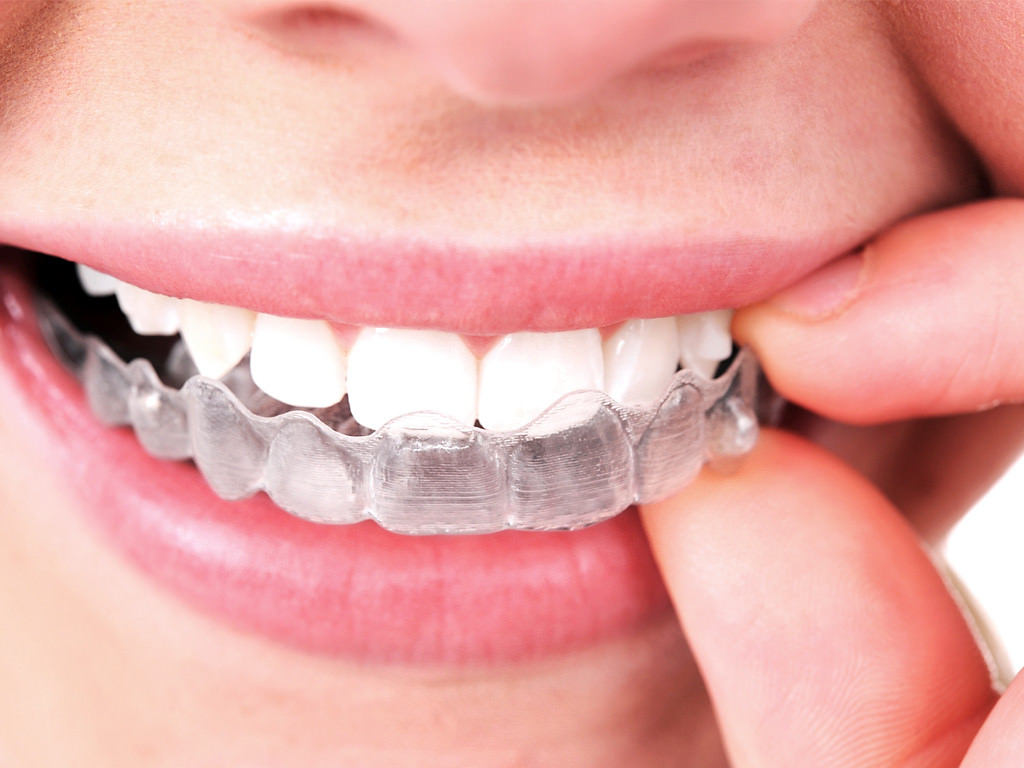Gaps between teeth are one of the top complaints that patients have when asked about how they feel about their smile. And while Invisalign is well known as an alternative to braces for straightening teeth, it is also a good option for mild to moderate crowding and crookedness. So, when patients ask our dentists “Does Invisalign work for closing gaps?” we point them to following facts:
What Causes Gaps Between Teeth?

The tops causes of a tooth gap are:
- Teeth are small relative to size of the jaw
- Extended frenum (piece of tissue connecting the lip to gums
- Chronic thumb sucking (in childhood)
- Gum disease
The medical term for a space between the teeth is a diastema, and some can be quite wide. The most common place for a gap is right between the front teeth (called incisors) but gaps can appear anywhere in the mouth. This usually happens when the size of a person’s teeth are small in relation to the size of their jaw.
Another cause of a gap between the front teeth is the small piece of tissue that connects the upper lip to the gums. This is called the frenum, or frenulum, and if it is too big, it can extend down between the two teeth, pushing them apart. This condition, as well as the size of the teeth and jaw, aure usually hereditary.
Gaps can develop in other ways too. Chronic thumb sucking may force the teeth apart. Some babies also have tongue thrust, which is a problem with the swallowing reflex that can help form a space.
Finally, gum disease can cause a deterioration of the tooth enamel, which will widen any gaps that already exist.
Are Gaps Something to Worry About?

Spaces between teeth might not seem like a big deal. Some celebrities are even known for their gapped teeth. But in some cases, gaps can be problematic. In terms of dental health, it can be easy for decay-causing food to get caught in spaces between teeth, forming cavities. And a large area of exposed gum tissue can make gum disease a possibility. If a patient is diligent about their oral hygiene, a gap doesn’t have to cause a problem.
More often, patients want to fix their gaps for cosmetic reasons. They may not like the way it looks with a wide space, especially if it’s front-and-center when they smile. A large tooth gap might also cause a lisp, whistle, or other speech problem. There are basically two ways to get rid of a tooth gap. Either the teeth need to move, or something must be done to mask or hide the space.
How Invisalign Works to Close Gaps

Invisalign gradually moves teeth using clear plastic aligner trays. These trays are custom made from 3D imprints of a patient’s teeth and are worn for about 22 hours each day. The sets are switched out for new ones every two weeks. With each new set, the hard plastic aligner tray moves the teeth closer together, eventually closing the gap. At the same time, any other teeth that are crowded together or crooked can be moved and corrected too.
The process takes on average from six months to a year. If the gap is large, it could take longer. It’s also important to note that Invisalign is meant for mild to moderate problems, so it may not be the best choice for all tooth-alignment issues. If a space is too wide, or if the teeth are extremely crooked, traditional braces might get better results.
Other Ways to Close or Hide a Gap

Braces. Braces use a lot of force to move teeth, so if a patient has a huge gap or another serious alignment issue, they might be the best bet. They can move even the most stubborn teeth just about anywhere.
Braces have their drawbacks, though. Even clear braces are more noticeable than Invisalign, and they can’t be removed for eating and brushing. Treatment can also take longer and be more painful. Unless a gap is very wide and there are a lot of other things to fix, Invisalign can probably be just as effective.
Retainers. Retainers are usually used after braces or Invisalign treatment to keep recently moved teeth in alignment. If a gap starts to reappear several months or years after a patient has had his or her teeth moved, a retainer might be useful all by itself to fix the problem.
Frenectomy. A frenectomy is a simple procedure where the piece of tissue that attaches the top lip to the gums is surgically removed. If this small section of tissue is forcing the front teeth apart, its removal will allow the gap to close. A frenectomy might be followed by braces or Invisalign to move the teeth into place.
Bonding. Cosmetic bonding won’t move teeth to close a gap, but it can mask its appearance. Bonding involves adding small amounts of tooth-colored composite material to the tooth. The dentist can “build up” the surfaces between two teeth, closing the amount of space between them. If the gap is too large, it could take a lot of material. This could give the teeth an odd, unnatural looking shape, so it is best used only for narrow gaps.
Crowns or Veneers. Crowns and veneers are most often used to cap or cover teeth that have decayed, or that have chips, cracks, or are discolored. They might, however, solve the problem of a tooth gap. Crowns fit over the entire tooth, while veneers cover only the front. Both can be made of composite or porcelain so that they look and feel like natural teeth.
For the purpose of fixing a gap, a crown or veneer can be made slightly bigger than the tooth. Once it’s in place, it fills in the empty space that was there. Obviously, this could look awkward in some situations, but if the size and location are right, it can be an option to fill up the empty space.
Tooth Gap Bands. Some people may wonder if there is a way to fix a tooth gap without a dentist’s or orthodontist’s help. They may be tempted to buy an over-the-counter product known as a tooth gap band. This is an inexpensive elastic band that is meant to be worn over the two teeth, pushing them toward one another. This method is not recommended and can actually harm the teeth. It can slide up beneath the gum tissue, causing irritation, infection, or even tooth loss. When it comes to any dental procedure that moves teeth, it is best to leave it to the professionals.
Choosing Invisalign for Gaps

When it comes to closing spaces in teeth, as well as correcting other alignment issues, there are several reasons why people choose Invisalign. Not only is Invisalign discrete, comfortable, and removable, it’s trusted by dentists and orthodontists all over the country. To find out if Invisalign will work to close the gaps in your teeth, first visit a dentist for a consultation. If you don’t have a dentist, you can find one with our search tool.


